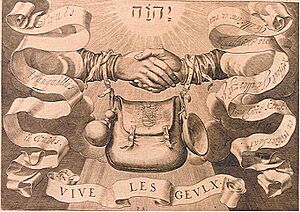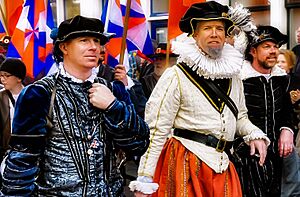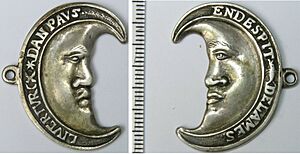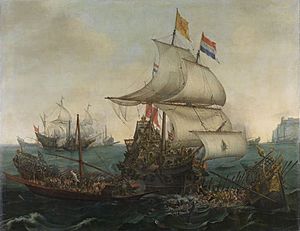Geuzen facts for kids

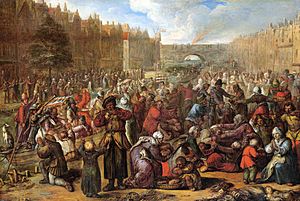
The Geuzen (pronounced GHEU-zen) was a name chosen by a group of Dutch nobles in the 1500s. They were Calvinists who stood against Spanish rule in the Netherlands starting in 1566.
The most successful group of Geuzen fought at sea. They were known as Watergeuzen (pronounced WAH-ter-gheu-zen), which means "Water Beggars" or "Sea Beggars." During the Eighty Years' War, these Sea Beggars captured the town of Brielle in 1572. This was a very important moment because it gave the rebels their first foothold on land. From there, they went on to conquer the northern parts of the Netherlands and create an independent country called the Dutch Republic.
Contents
How the Geuzen Got Their Name
The leaders of the nobles who formed a special group called the Compromise of Nobles were Louis of Nassau and Hendrick van Brederode. They promised to protect the rights and freedoms of the Netherlands from the strict rule of Philip II of Spain.
On April 5, 1566, about 250 nobles, led by Louis of Nassau and Brederode, went to the palace to present a list of their complaints to the regent, Margaret of Parma. Margaret was worried when she saw so many nobles. But one of her advisors, Charles de Berlaymont, supposedly said, "N'ayez pas peur Madame, ce ne sont que des gueux" ("Don't be afraid, madam, they are only beggars").
The nobles never forgot this name. Three days later, at a big gathering, Brederode announced that they were all ready to become "beggars" for their country's cause if needed. From then on, "Geuzen" became their proud name.
The Geuzen started wearing symbols of beggars, like a wallet and a bowl, on their hats or belts. They even made a special medal. One side showed the head of King Philip II. The other side showed two clasped hands with the words Fidèle au roy, jusqu'à porter la besace ("Loyal to the King, even to carrying the beggar's pouch"). The first group of Beggars didn't last long, as they were defeated by Duke of Alba. However, their ideas lived on and eventually led to victory.
In the Dutch language, the word geuzennaam is used for a term that was once negative but is now used with pride by the people it describes.
The "Sea Beggars" and Their Actions
In 1569, William I of Orange, who was now leading the revolt, gave special permission to many ships. These ships were crewed by brave sailors from different countries. Eighteen ships received these permissions, and they were set up by Louis of Nassau in the French port of La Rochelle, which they used as their main base.
These sailors, led by daring commanders like William de la Marck, Lord of Lumey, were called "Sea Beggars." At first, they mostly robbed ships and land, taking their stolen goods to English ports where they could fix their ships and get more supplies. By the end of 1569, there were already 84 Sea Beggar ships in action.

However, in 1572, Queen Elizabeth I of England suddenly stopped letting the Sea Beggars use her harbors. Without a safe place to go, the Sea Beggars, led by De la Marck, Willem Bloys van Treslong, and Lenaert Jansz de Graeff, made a surprise attack on the town of Brielle. They captured it on April 1, 1572, because the Spanish soldiers were not there.
This success encouraged them. They then sailed to Vlissingen, which they also captured quickly. Taking these two towns caused many nearby towns to join the revolt. This started a chain reaction that led to most of Holland joining a general uprising in the Netherlands. This event is seen as the true beginning of Dutch independence.
In 1573, the Sea Beggars defeated a Spanish fleet near the port of Hoorn in the Battle on the Zuiderzee. They mixed with the local people and quickly started rebellions against Duke of Alba in many towns, spreading the resistance south.
In 1574, the Sea Beggars, led by Admiral Louis de Boisot, helped to free the city of Leiden during the Siege of Leiden.
Some of the ancestors of famous Dutch naval heroes started their careers as Sea Beggars. For example, Evert Heindricxzen was the grandfather of Cornelis Evertsen the Elder.
Geuzen Symbols and Their Meaning
As part of their efforts to spread their message, the Geuzen created many Geuzen medals. These medals were like badges that showed who they supported. They used various symbols, including some linked to the Ottoman Empire. William I of Orange even tried to get help from the Ottoman Empire against the Spanish king Philip II.
The "Geuzen" wanted to show their strong feelings against Spain and the Catholic Church. They believed the Turks were less of a threat than the Spanish. Between 1579 and 1582, representatives from the Ottoman Empire even traveled from Istanbul to Antwerp several times.
There was a good reason for such an alliance. At the same time the Dutch rebels were attacking Spanish ships, the Ottoman Empire was fighting its own naval war with Spain. This led to the 1571 Battle of Lepanto in Greece. If Spain had to fight both the Ottomans in the Mediterranean and the Dutch in northern Europe, it would be a big advantage for both of Spain's enemies.
The slogan Liever Turks dan Paaps ("Rather Turkish than Papist") was mostly a strong statement. Their beggar medals shaped like a half-moon were symbolic. The Dutch didn't actually want to live under the Sultan. Also, there was no direct contact between the Geuzen and Turkish leaders. The Turks were seen as non-believers, and the religion of Islam alone kept them from playing a more central role in the rebels' message.
Images for kids
-
Another view of the Battle on the Zuiderzee
-
The Geuzen arriving with Boisot at Leiden during the Siege of Leiden
-
The Prince of Orange and Watergeuzen entering Leiden after its siege
See also


